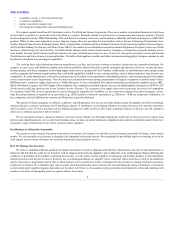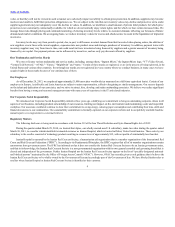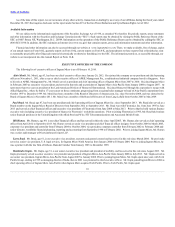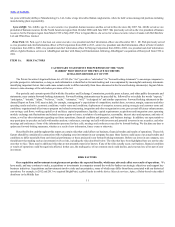Ingram Micro 2013 Annual Report Download - page 18
Download and view the complete annual report
Please find page 18 of the 2013 Ingram Micro annual report below. You can navigate through the pages in the report by either clicking on the pages listed below, or by using the keyword search tool below to find specific information within the annual report.
Table of Contents
We endeavor to monitor these financial institutions regularly for credit quality; however, we are exposed to risk of loss on such funds or we may experience
significant disruptions in our liquidity needs if one or more of these financial institutions were to suffer bankruptcy or similar restructuring.
We cannot predict what losses we might incur in litigation matters and contingencies that we may be involved with from time to time. There
are various claims, lawsuits and pending actions against us. It is our opinion that the ultimate resolution of these matters will not have a material adverse effect
on our consolidated financial position, results of operations or cash flows. However, we can make no assurances that we will ultimately be successful in our
defense of any of these matters. See Part I. Item 3. “Legal Proceedings,” in this Form 10-K for a discussion of our material legal matters.
We may become involved in intellectual property disputes that could cause us to incur substantial costs, divert the efforts of management
or require us to pay substantial damages or licensing fees. From time to time, we receive notifications alleging infringements of intellectual property
rights allegedly held by others relating to the products or services we sell. Litigation with respect to patents or other intellectual property matters could result in
substantial costs and diversion of management and other resources and could have an adverse effect on our operations. Further, we may be obligated to
indemnify and defend our customers if the products or services we sell are alleged to infringe any third party’s intellectual property rights. While we may be
able to seek indemnification from our suppliers to protect our customers and us against such claims, there is no assurance that we will be successful in
obtaining such indemnification or that we will be fully protected against such claims. We may also be prohibited from marketing products, could be forced to
market products without desirable features, or could incur substantial costs to defend legal actions, including where third parties claim that we or vendors
who may or may not have indemnified us are infringing upon their intellectual property rights. In recent years, individuals and groups have begun purchasing
intellectual property assets for the sole purpose of making claims of infringement and attempting to extract settlements from target companies. Even if we
believe that such infringement claims are without merit, the claims can be time-consuming and costly to defend and divert management’s attention and
resources away from our business. Claims of intellectual property infringement may require us to enter into costly settlements or pay costly damage awards, or
face a temporary or permanent injunction prohibiting us from marketing or selling certain products or services, which could affect our ability to compete
effectively. If an infringement claim is successful, we may be required to pay damages or seek royalty or license arrangements, which may not be available on
commercially reasonable terms. Even if we have an agreement that indemnifies us against such costs, the indemnifying party may be unable or unwilling to
uphold its contractual obligations to us.
Our failure to comply with the requirements of environmental regulations could adversely affect our business. We are subject to various
federal, state, local and foreign laws and regulations addressing environmental and other impacts from product disposal, use of hazardous materials in
products, recycling of products at the end of their useful life and other related matters. Compliance with these environmental laws may have a material adverse
effect on our business. These laws include the European Union Waste Electrical and Electronic Equipment Directive as enacted by individual European Union
countries and other similar legislation adopted in North America, which make producers of electrical goods, including computers and printers, responsible for
collection, recycling, treatment and disposal of recovered products. While we strive to ensure we are in compliance with all applicable regulations, certain of
these regulations impose strict liability. Additionally, we may be held responsible for the prior activities of entities that we have acquired. Failure to comply or
allegations of non-compliance with these regulations could result in substantial costs, fines and civil or criminal sanctions, as well as third-party claims for
property damage or personal injury. Further, environmental laws may become more stringent over time, imposing greater compliance costs and increasing
risks and penalties associated with violation.
We face a variety of risks in our reliance on third-party service companies, including shipping companies for the delivery of our products
and outsourcing arrangements. We rely almost entirely on arrangements with third-party shipping and freight forwarding companies for the delivery of our
products. The termination of our arrangements with one or more of these third-party shipping companies, or the failure or inability of one or more of these
third-party shipping companies to deliver products from suppliers to us or products from us to our customers, could disrupt our business and harm our
reputation and operating results.
In addition, we have outsourced various transaction-oriented service and support functions to business process outsource providers. We have also
outsourced a significant portion of our IT infrastructure function and certain IT application development functions to third-party providers. We may outsource
additional functions to third-party providers. Our reliance on third-party providers to provide service to us, our customers and suppliers and for our IT
requirements to support our business could result in significant disruptions and costs to our operations, including damaging our relationships with our
suppliers and customers, if these third-party providers do not meet their obligations to adequately maintain an appropriate level of service for the outsourced
functions or fail to adequately support our IT requirements. As a result of our outsourcing activities, it may also be more difficult to recruit and retain
qualified employees for our business needs.
Changes in accounting rules could adversely affect our future operating results. Our consolidated financial statements are prepared in accordance
with U.S. generally accepted accounting principles. These principles are subject to interpretation by
18
























